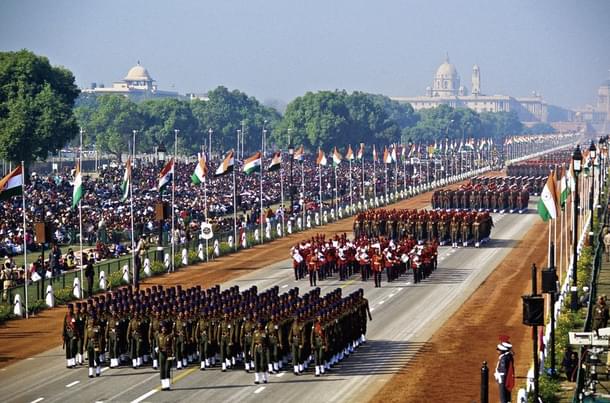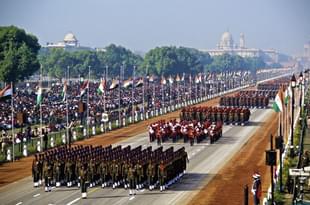Politics
Looking East On Republic Day: A Big Time Opportunity For India To Take ASEAN Ties To A New Level
Ashok Sajjanhar
Jan 26, 2018, 11:01 AM | Updated 11:01 AM IST
Save & read from anywhere!
Bookmark stories for easy access on any device or the Swarajya app.


All 10 leaders of Association of Southeast Asian Nations (ASEAN) nations will be guests of honour at India's Republic Day celebrations today - 26 January 2018. Yesterday (25 January) they participated in a Commemorative Summit with a retreat at the Rashtrapati Bhavan designed to promote understanding and cooperation and take relations to newer heights. It is a measure of India's growing international profile and prestige that leaders of these countries readily acquiesced in participating in this event. This will impart a significant impetus to realising objectives of the Act East Policy (AEP).
President Sukarno of Indonesia was the first world leader to be invited as chief guest to India's Republic Day in 1950. Since then, only once again has a leader from Indonesia been invited by India in this capacity. Over the intervening years, Cambodia, Singapore, Thailand and Vietnam have also once each graced the Republic Day rostrum with the president and prime minister of India. Five leaders from ASEAN countries will hence be accorded this honour for the first time when the 10 leaders of ASEAN congregate to witness the R-Day parade tomorrow and get acquainted with the military might and dazzling cultural and ethnic diversity of India. It will be an unprecedented and momentous occasion as never before to have such a large number of world leaders attending together as guests of honour for the R-Day. Prior to this, only on three earlier occasions, have two leaders from different countries been invited as guests of honour. This occasion will hence be scripting history in more ways than one.
The event will, however, not only be pomp and show, whistles and spectacle. Even more important will be the substantive and wide ranging discussions that will take place between these leaders and Prime Minister Narendra Modi, both bilaterally and collectively. The significance of these deliberations increases manifold as several uncertainties and challenges plague the region. A strong partnership between these countries and India can be hugely beneficial for security, stability, peace and prosperity in these countries, the region and the world.
In addition to the twenty-fifth anniversary of bilateral partnership between India and ASEAN, the occasion also celebrates 50 years of establishment of ASEAN, 15 years of India-ASEAN Summit relationship and five years of the bilateral strategic partnership, which concluded at the last Commemorative Summit in 2012 to mark the completion of 20 years of India's Look East Policy (LEP) launched in 1992.
This is not to suggest that India's relations with Southeast Asia are merely a few decades old. On the contrary they span over several millennia. India shares long-standing historical, cultural and civilisational links with Southeast Asia.
India and Southeast Asian countries were, however, not able to fully utilise the potential of this deep-rooted legacy after India became independent in 1947. In the initial years there was great empathy and support for the independence struggles in the region. Dynamics of Cold War politics, however, took over from the late 1950s as India was seen to be close to the Soviet Union and major Southeast Asian countries were considered to belong to the western camp led by the USA.
Look East Policy
End of the Cold War and disintegration of the Soviet Union in 1991 provided a unique opportunity to India to reach out to Southeast Asia/ASEAN to capitalise on its historical linkages and integrate its economy with the booming economies of the region. The collapse of Soviet Union had resulted in severely damaging the Indian economy leading to initiation of path-breaking trade, industrial and economic reforms. Closer coordination with ASEAN was seen as essential to bring the Indian economy out of the morass. This led to the launch of the Look East Policy.
For the first 20 years, after adoption of this initiative, there was no looking back. India and ASEAN entered into a summit partnership in 2002, on the tenth anniversary of LEP, and launched negotiations for a Free Trade Agreement (FTA) in goods in 2003. These discussions culminated in a bilateral deal being concluded in 2009 and coming into force in 2010. Bilateral trade and investment has shown impressive gains since launch of LEP. While bilateral trade increased from $2.9 billion in 1992 to $12 billion in 2002, registering a growth of 12 per cent annually, it zoomed to $72 billion in 2012 with a cumulative annual growth rate of around 23 per cent over the preceding 10 years. India’s two-way trade with ASEAN currently stands at approximately $70 billion. The India-ASEAN Free Trade pact in services and investments which came into effect in 2015 has the potential to reduce India's trade deficit with the region as also impart a strong impulse to bilateral exchanges.
Act East Policy
Act East Policy as the successor to Look East Policy was initiated by Prime Minister Modi during the East Asia Summit in November, 2014 within six months of his assuming power. It was felt that LEP had started losing steam and had become stagnant. AEP sought to enhance the geographical coverage of the policy to include East Asian countries comprising Japan, Australia, New Zealand, Pacific Island States, Republic of Korea etc.
Scope of engagement has been expanded to put greater focus on security, connectivity, strategic, political, counter-terrorism, anti-radicalisation, maritime security, defence collaboration, soft power, people to people contact in addition to trade and investment. Cooperation to curb terrorism especially in the face of rising influence of Islamic State has assumed priority. Defence partnerships with several ASEAN states have been prioritised. Commerce, connectivity and culture have become the principal aims of AEP.
In addition, security, stability and economic prosperity of northeastern states of India have emerged as essential objectives of AEP. The economy of northeastern states can get a significant boost by promoting connectivity with ASEAN.
The visit by the 10 leaders of ASEAN to India for the Commemorative Summit provides a welcome opportunity to both sides to discuss and resolve issues of concern and promote themes of mutual interest.
Connectivity between India and ASEAN, particularly with Myanmar and Thailand, has emerged as a significant factor in cementing bonds between the two regions. Better infrastructure connecting northeast India and ASEAN has become the sine qua non for stronger trade and economic partnership and vital contributor to prosperity and economic development of the Indian states. Two major connectivity projects viz Trilateral highway between northeast India and Myanmar and onwards to Thailand (and Laos and Vietnam) has been under implementation for several years. The same is valid for the Kaladan multi-modal transit and transport project. Allocation of $1 billion by Modi during his visit to Malaysia in September 2015 to support physical and digital connectivity is testimony to the importance that India attaches to this important subject. Both these projects need to be taken up on a priority base and concluded expeditiously.
Discussions on the Regional Comprehensive Economic Partnership have been in progress since 2012. They need to be concluded quickly and a balanced and satisfactory outcome acceptable to all participants needs to be achieved. India's credibility as an active and serious proponent of globalisation will be judged by the effort and time it is able to invest in bringing these negotiations to a fair and equitable conclusion.
ASEAN continues to form the central pillar of India’s Act East Policy. This is evident from the very active exchange of visits that has taken place between India and this region particularly since the Modi government came to power.
India, ASEAN, And The Chinese Conundrum
In a rapidly evolving geo-political scenario marked by assertive military, political and economic rise of China, AEP has imparted greater dynamism to India’s ties with ASEAN.
Issue of ownership, control, usage and exploitation of oil, gas, minerals and fisheries resources in the South China Sea has emerged as a major dispute between China and several ASEAN countries like Vietnam, Philippines, Brunei and Malaysia. This is an issue that has divided ASEAN down the middle. India is concerned because more than 40 per cent of its trade passes through the South China Sea. It is also interested in harnessing fossil fuel resources in the region for meeting its energy needs. In all recent discussions in regional and international fora, India along with several others have supported freedom of navigation, ensuring maritime security, expeditious resolution of disputes according to provisions of international law viz UN Convention on the Law of the Seas 1982, developing a Code of Conduct, and settlement of the dispute through dialogue and peaceful means.
China’s increasing intemperance and intractability over the last many years has added to anxieties and concerns of countries in South East Asia and beyond. They want India to play a more active countervailing role in the region. This interest and desire on the part of these countries meshes flawlessly with the efforts by India to reach out pro-actively to countries of the region for mutually beneficial engagements.
How to manage relations with China and deal with its aggressiveness is likely to feature prominently in bilateral deliberations between Prime Minister Modi and leaders of visiting ASEAN nations like Vietnam, Singapore, Malaysia, Thailand, Brunei and Indonesia. Discussions on organising joint maritime exercises with individual ASEAN nations and expanding cooperation in maritime security could be concrete outcomes of the summit. Involvement of individual ASEAN countries in the informal, official level consultations amongst the ‘’Quad’’ nations (USA, India, Japan, Australia) which were initiated in Manila on the sidelines of EAS in November 2017, after an interregnum of many years, could also come up for discussions between India and some ASEAN leaders.
Conclusion
India and ASEAN account for about 30 per cent of the global population (i.e. 1.85 billion people) and a combined gross domestic product of approximately $5.1 trillion. Together they would form the third largest economy in the world. Given their combined heft, they need to expand their areas of collaboration particularly in view of rapidly changing and uncertain global and regional scenario.
Promotion of India’s geostrategic interests in the Indo-Pacific region depends on India’s bilateral and multilateral/regional engagements with the countries in the region. It is hence essential to strengthen collaboration with ASEAN as an organisation as well as with individual Southeast Asian countries.
Despite the progress made over the last 25 years in India-ASEAN ties, there remains immense scope for further growth in the relationship. The presence of the ASEAN leadership in New Delhi for three days is an unparalleled opportunity to resolve all outstanding issues and take bilateral and regional ties in connectivity projects, trade and investment, maritime security to newer heights.
The author is a former Ambassador of India to Kazakhstan, Sweden and Latvia. He is currently President, Institute of Global Studies.”





